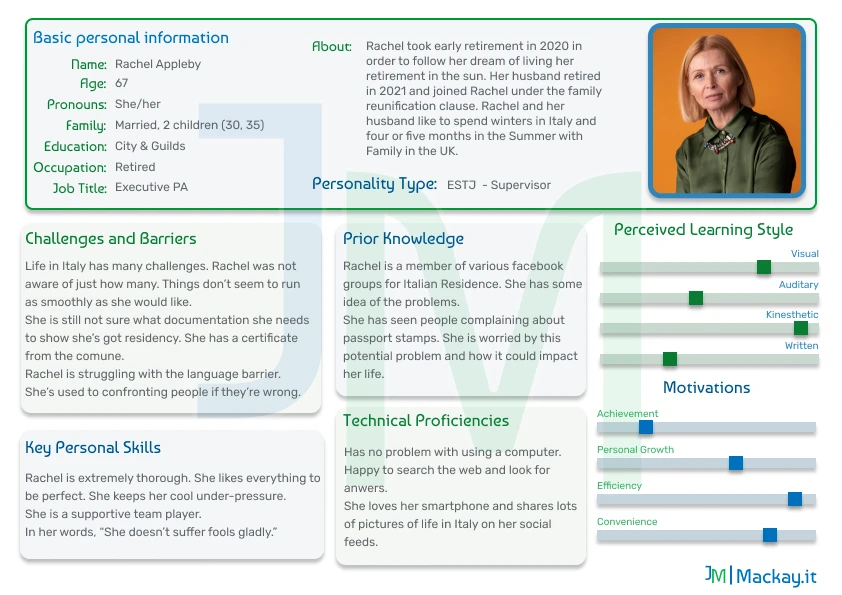How personas can be used within Instructional Design to improve learning experiences

April is a 43-year-old working mother of 3 children. April graduated from university 15 years ago. She met her husband Stefan on graduation day. April works part-time in the marketing department at Robin’s Outfitters. Her primary responsibilities are within social media campaigns. At the weekend she can be found running between different sporting events for her children.

Sam is 25 and uses the pronouns they/them. They work within the social media team at Snow, Ski and Sundries. Sam got their high school diploma and got themselves a job. High school was not a good experience for Sam. They did not enjoy formal education. They are in a loving relationship with their partner Peter. Sam and Peter have two cats that they dote on. They love nothing more than a quiet movie night watching a blockbuster from the 1960s.
Robin’s Outfitters and Snow, Ski and Sundries have agreed upon a merger. The two companies have had very different approaches to marketing. You’ve been working with the merger team and found skills and procedures that need aligning.
April and Sam are examples of the type of learners we will be helping. They are Personas. They each represent a particular part of the learner population.
What is a Persona?
From the ID point of view, a persona is a representation of the learners involved in our project. The persona should be fictional to an extent. That is, they shouldn’t focus on a particular individual or stereotype. They will develop out of the questions we ask during the analysis phase. Asking the right questions about who the learners are is important.
The persona will give us detailed information about the learners’ work and home life. We will gain insight into users’ ambitions, values and opinions. They will help us understand the problems and challenges from the learners’ perspective.
Why do we need Personas?
Personas open the door to a human-centred design experience. Personas give us the learners’ context, and the work context offers a 360º approach to context.
Understanding our learners better allows for a more targeted approach to creating activities. Learning events and activities can then be scaffolded appropriately to enhance deeper learning. Even within the short personas of April and Sam, we have a lot of insights. We understand that April is more comfortable with formal learning compared to Sam. This will certainly inform our approaches to activity planning. We also have a reminder that Sam uses they/them pronouns. If we use names within our activities, we may want to remember to include a range of pronouns. Already, we’re designing our activities to be more accessible and inclusive. Being more inclusive helps everyone.
Imagine how much more insight a detailed Persona can tell us about our future learners.
How can we make personas for our Instructional Design project?
There are many templates floating around the web. Most templates focus on the use within the User Experience (UX) design world. This is where the main concepts have been developed and enhanced. Thus not all aspects of these templates are relevant to us and could cause confusion. We can use the main concepts as a starting point and adapt the content to our specific needs.
What aspects are relevant?
To arrive at this list, I have gone through about 10 of the most popular instructional design models. I’ve create a strong set of user information that can help us understand what our learners need.
Biometric and Biographical Information
[This can include, Name, age, position, where they live, family background, education background. If you’re familiar with the workings of MBTI then you may include personality type.]
This helps to add balance and context to the learning events and materials you are preparing. You may be able to find some hooks to help support the material you are preparing too.
Challenges and Barriers
This helps you understand why they need this learning experience. What are the problems they are encountering at work? How these learning events or support materials may help them. It is a quick check to make sure you are address the challenges and barriers they are experiencing.

Prior knowledge
It’s a good idea to consider what they already know about the subject. Have they done any training on this topic before? What material is available to support them already?
A valuable reminder, there is a lot of prior knowledge and experience that comes with every user. Be mindful that at least some of the audience will have experience in the subject matter. This helps to remind us that start points for learners are different. We can’t expect a one-size-fits-all approach will work.
Skills
What are the core skills that they use in their job already? What are the things they are good at, and equally what are some aspects that they are looking to improve?
This is useful for any form of training not just if you’re looking to create a behavioural shift. It again can give you an edge and a place to build from. Your learning events could use the stronger skills to build new skills or knowledge.
Perceived learning styles
We know the research does not support the educational benefit of learning styles. They do still have some place in the consideration of how users feel they learn best. That perception can be helpful in making the activity or material more digestible. So, it is worth considering as we create material, making them easier for our learners to engage with.
Motivations
What are the intrinsic motivators that will help them to engage with the content?
We can’t hold everyone’s toes over the fire while they submit to our training. We need to try and tap into the intrinsic motivators. What will help them adapt or adopt the behaviours or knowledge we want them to be able to show?
Technology proficiencies
Are they able to use computers and mobile devices without too many problems? Are they able to troubleshoot problems themselves? Do they call on a younger member of the team to help them? Do they need IT support?
This can help you plan ahead. It can help remind you to make sure you are ready to help tech support possible issues. Taking time to think through access issues that can occur, will save you time and energy later.
What should you do when you’ve created your persona?
Check it with your client, and if possible, the HR department. They should be able to tell you if the person you’ve created is a good representation of staff within their office. Finally, make any adjustments they see as appropriate. This will help ensure that your persona is as effective as possible. You can be sure that when you begin to address the persona, you are conversing with your future learner.
If you’d like my help and support with creating Personas for your project, or help developing your content then let’s connect.